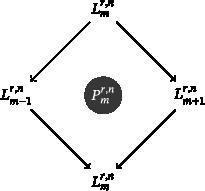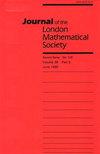下载PDF
{"title":"sl²$\\widehat{\\mathfrak {sl}}_2$的权模在容许水平上的张量范畴","authors":"Thomas Creutzig","doi":"10.1112/jlms.70037","DOIUrl":null,"url":null,"abstract":"<p>The category of weight modules <span></span><math>\n <semantics>\n <mrow>\n <msub>\n <mi>L</mi>\n <mi>k</mi>\n </msub>\n <mrow>\n <mo>(</mo>\n <msub>\n <mi>sl</mi>\n <mn>2</mn>\n </msub>\n <mo>)</mo>\n </mrow>\n <mo>-wtmod</mo>\n </mrow>\n <annotation>$L_{k}(\\mathfrak {sl}_2)\\operatorname{-wtmod}$</annotation>\n </semantics></math> of the simple affine vertex algebra of <span></span><math>\n <semantics>\n <msub>\n <mi>sl</mi>\n <mn>2</mn>\n </msub>\n <annotation>$\\mathfrak {sl}_2$</annotation>\n </semantics></math> at an admissible level <span></span><math>\n <semantics>\n <mi>k</mi>\n <annotation>$k$</annotation>\n </semantics></math> is neither finite nor semisimple and modules are usually not lower-bounded and have infinite-dimensional conformal weight subspaces. However, this vertex algebra enjoys a duality with <span></span><math>\n <semantics>\n <mrow>\n <msub>\n <mi>W</mi>\n <mi>ℓ</mi>\n </msub>\n <mrow>\n <mo>(</mo>\n <msub>\n <mi>sl</mi>\n <mrow>\n <mn>2</mn>\n <mo>|</mo>\n <mn>1</mn>\n </mrow>\n </msub>\n <mo>)</mo>\n </mrow>\n </mrow>\n <annotation>$\\mathcal {W}_\\ell (\\mathfrak {sl}_{2|1})$</annotation>\n </semantics></math>, the simple principal <span></span><math>\n <semantics>\n <mi>W</mi>\n <annotation>$\\mathcal {W}$</annotation>\n </semantics></math>-algebra of <span></span><math>\n <semantics>\n <msub>\n <mi>sl</mi>\n <mrow>\n <mn>2</mn>\n <mo>|</mo>\n <mn>1</mn>\n </mrow>\n </msub>\n <annotation>$\\mathfrak {sl}_{2|1}$</annotation>\n </semantics></math> at level <span></span><math>\n <semantics>\n <mi>ℓ</mi>\n <annotation>$\\ell$</annotation>\n </semantics></math> (the <span></span><math>\n <semantics>\n <mrow>\n <mi>N</mi>\n <mo>=</mo>\n <mn>2</mn>\n </mrow>\n <annotation>$N=2$</annotation>\n </semantics></math> super conformal algebra) where the levels are related via <span></span><math>\n <semantics>\n <mrow>\n <mo>(</mo>\n <mi>k</mi>\n <mo>+</mo>\n <mn>2</mn>\n <mo>)</mo>\n <mo>(</mo>\n <mi>ℓ</mi>\n <mo>+</mo>\n <mn>1</mn>\n <mo>)</mo>\n <mo>=</mo>\n <mn>1</mn>\n </mrow>\n <annotation>$(k+2)(\\ell +1)=1$</annotation>\n </semantics></math>. Every weight module of <span></span><math>\n <semantics>\n <mrow>\n <msub>\n <mi>W</mi>\n <mi>ℓ</mi>\n </msub>\n <mrow>\n <mo>(</mo>\n <msub>\n <mi>sl</mi>\n <mrow>\n <mn>2</mn>\n <mo>|</mo>\n <mn>1</mn>\n </mrow>\n </msub>\n <mo>)</mo>\n </mrow>\n </mrow>\n <annotation>$\\mathcal {W}_\\ell (\\mathfrak {sl}_{2|1})$</annotation>\n </semantics></math> is lower-bounded and has finite-dimensional conformal weight spaces. The main technical result is that every weight module of <span></span><math>\n <semantics>\n <mrow>\n <msub>\n <mi>W</mi>\n <mi>ℓ</mi>\n </msub>\n <mrow>\n <mo>(</mo>\n <msub>\n <mi>sl</mi>\n <mrow>\n <mn>2</mn>\n <mo>|</mo>\n <mn>1</mn>\n </mrow>\n </msub>\n <mo>)</mo>\n </mrow>\n </mrow>\n <annotation>$\\mathcal {W}_\\ell (\\mathfrak {sl}_{2|1})$</annotation>\n </semantics></math> is <span></span><math>\n <semantics>\n <msub>\n <mi>C</mi>\n <mn>1</mn>\n </msub>\n <annotation>$C_1$</annotation>\n </semantics></math>-cofinite. The existence of a vertex tensor category follows and the theory of vertex superalgebra extensions implies the existence of vertex tensor category structure on <span></span><math>\n <semantics>\n <mrow>\n <msub>\n <mi>L</mi>\n <mi>k</mi>\n </msub>\n <mrow>\n <mo>(</mo>\n <msub>\n <mi>sl</mi>\n <mn>2</mn>\n </msub>\n <mo>)</mo>\n </mrow>\n <mo>-wtmod</mo>\n </mrow>\n <annotation>$L_{k}(\\mathfrak {sl}_2)\\operatorname{-wtmod}$</annotation>\n </semantics></math> for any admissible level <span></span><math>\n <semantics>\n <mi>k</mi>\n <annotation>$k$</annotation>\n </semantics></math>. As applications, the fusion rules of ordinary modules with any weight module are computed, and it is shown that <span></span><math>\n <semantics>\n <mrow>\n <msub>\n <mi>L</mi>\n <mi>k</mi>\n </msub>\n <mrow>\n <mo>(</mo>\n <msub>\n <mi>sl</mi>\n <mn>2</mn>\n </msub>\n <mo>)</mo>\n </mrow>\n <mo>-wtmod</mo>\n </mrow>\n <annotation>$L_{k}(\\mathfrak {sl}_2)\\operatorname{-wtmod}$</annotation>\n </semantics></math> is a ribbon category if and only if <span></span><math>\n <semantics>\n <mrow>\n <msub>\n <mi>L</mi>\n <mrow>\n <mi>k</mi>\n <mo>+</mo>\n <mn>1</mn>\n </mrow>\n </msub>\n <mrow>\n <mo>(</mo>\n <mi>g</mi>\n <mo>)</mo>\n </mrow>\n <mo>-wtmod</mo>\n </mrow>\n <annotation>$L_{k+1}(\\mathfrak g)\\operatorname{-wtmod}$</annotation>\n </semantics></math> is, in particular, it follows that for admissible levels <span></span><math>\n <semantics>\n <mrow>\n <mi>k</mi>\n <mo>=</mo>\n <mo>−</mo>\n <mn>2</mn>\n <mo>+</mo>\n <mfrac>\n <mi>u</mi>\n <mi>v</mi>\n </mfrac>\n </mrow>\n <annotation>$k = - 2 + \\frac{u}{v}$</annotation>\n </semantics></math> and <span></span><math>\n <semantics>\n <mrow>\n <mi>v</mi>\n <mo>∈</mo>\n <mo>{</mo>\n <mn>2</mn>\n <mo>,</mo>\n <mn>3</mn>\n <mo>}</mo>\n </mrow>\n <annotation>$v \\in \\lbrace 2, 3\\rbrace$</annotation>\n </semantics></math> and <span></span><math>\n <semantics>\n <mrow>\n <mi>u</mi>\n <mo>=</mo>\n <mo>−</mo>\n <mn>1</mn>\n <mspace></mspace>\n <mi>mod</mi>\n <mspace></mspace>\n <mi>v</mi>\n </mrow>\n <annotation>$u = -1 \\mod {v}$</annotation>\n </semantics></math>, the category <span></span><math>\n <semantics>\n <mrow>\n <msub>\n <mi>L</mi>\n <mi>k</mi>\n </msub>\n <mrow>\n <mo>(</mo>\n <msub>\n <mi>sl</mi>\n <mn>2</mn>\n </msub>\n <mo>)</mo>\n </mrow>\n <mo>-wtmod</mo>\n </mrow>\n <annotation>$L_{k}(\\mathfrak {sl}_2)\\operatorname{-wtmod}$</annotation>\n </semantics></math> is a ribbon category.</p>","PeriodicalId":49989,"journal":{"name":"Journal of the London Mathematical Society-Second Series","volume":"110 6","pages":""},"PeriodicalIF":1.0000,"publicationDate":"2024-11-29","publicationTypes":"Journal Article","fieldsOfStudy":null,"isOpenAccess":false,"openAccessPdf":"https://onlinelibrary.wiley.com/doi/epdf/10.1112/jlms.70037","citationCount":"0","resultStr":"{\"title\":\"Tensor categories of weight modules of \\n \\n \\n \\n sl\\n ̂\\n \\n 2\\n \\n $\\\\widehat{\\\\mathfrak {sl}}_2$\\n at admissible level\",\"authors\":\"Thomas Creutzig\",\"doi\":\"10.1112/jlms.70037\",\"DOIUrl\":null,\"url\":null,\"abstract\":\"<p>The category of weight modules <span></span><math>\\n <semantics>\\n <mrow>\\n <msub>\\n <mi>L</mi>\\n <mi>k</mi>\\n </msub>\\n <mrow>\\n <mo>(</mo>\\n <msub>\\n <mi>sl</mi>\\n <mn>2</mn>\\n </msub>\\n <mo>)</mo>\\n </mrow>\\n <mo>-wtmod</mo>\\n </mrow>\\n <annotation>$L_{k}(\\\\mathfrak {sl}_2)\\\\operatorname{-wtmod}$</annotation>\\n </semantics></math> of the simple affine vertex algebra of <span></span><math>\\n <semantics>\\n <msub>\\n <mi>sl</mi>\\n <mn>2</mn>\\n </msub>\\n <annotation>$\\\\mathfrak {sl}_2$</annotation>\\n </semantics></math> at an admissible level <span></span><math>\\n <semantics>\\n <mi>k</mi>\\n <annotation>$k$</annotation>\\n </semantics></math> is neither finite nor semisimple and modules are usually not lower-bounded and have infinite-dimensional conformal weight subspaces. However, this vertex algebra enjoys a duality with <span></span><math>\\n <semantics>\\n <mrow>\\n <msub>\\n <mi>W</mi>\\n <mi>ℓ</mi>\\n </msub>\\n <mrow>\\n <mo>(</mo>\\n <msub>\\n <mi>sl</mi>\\n <mrow>\\n <mn>2</mn>\\n <mo>|</mo>\\n <mn>1</mn>\\n </mrow>\\n </msub>\\n <mo>)</mo>\\n </mrow>\\n </mrow>\\n <annotation>$\\\\mathcal {W}_\\\\ell (\\\\mathfrak {sl}_{2|1})$</annotation>\\n </semantics></math>, the simple principal <span></span><math>\\n <semantics>\\n <mi>W</mi>\\n <annotation>$\\\\mathcal {W}$</annotation>\\n </semantics></math>-algebra of <span></span><math>\\n <semantics>\\n <msub>\\n <mi>sl</mi>\\n <mrow>\\n <mn>2</mn>\\n <mo>|</mo>\\n <mn>1</mn>\\n </mrow>\\n </msub>\\n <annotation>$\\\\mathfrak {sl}_{2|1}$</annotation>\\n </semantics></math> at level <span></span><math>\\n <semantics>\\n <mi>ℓ</mi>\\n <annotation>$\\\\ell$</annotation>\\n </semantics></math> (the <span></span><math>\\n <semantics>\\n <mrow>\\n <mi>N</mi>\\n <mo>=</mo>\\n <mn>2</mn>\\n </mrow>\\n <annotation>$N=2$</annotation>\\n </semantics></math> super conformal algebra) where the levels are related via <span></span><math>\\n <semantics>\\n <mrow>\\n <mo>(</mo>\\n <mi>k</mi>\\n <mo>+</mo>\\n <mn>2</mn>\\n <mo>)</mo>\\n <mo>(</mo>\\n <mi>ℓ</mi>\\n <mo>+</mo>\\n <mn>1</mn>\\n <mo>)</mo>\\n <mo>=</mo>\\n <mn>1</mn>\\n </mrow>\\n <annotation>$(k+2)(\\\\ell +1)=1$</annotation>\\n </semantics></math>. Every weight module of <span></span><math>\\n <semantics>\\n <mrow>\\n <msub>\\n <mi>W</mi>\\n <mi>ℓ</mi>\\n </msub>\\n <mrow>\\n <mo>(</mo>\\n <msub>\\n <mi>sl</mi>\\n <mrow>\\n <mn>2</mn>\\n <mo>|</mo>\\n <mn>1</mn>\\n </mrow>\\n </msub>\\n <mo>)</mo>\\n </mrow>\\n </mrow>\\n <annotation>$\\\\mathcal {W}_\\\\ell (\\\\mathfrak {sl}_{2|1})$</annotation>\\n </semantics></math> is lower-bounded and has finite-dimensional conformal weight spaces. The main technical result is that every weight module of <span></span><math>\\n <semantics>\\n <mrow>\\n <msub>\\n <mi>W</mi>\\n <mi>ℓ</mi>\\n </msub>\\n <mrow>\\n <mo>(</mo>\\n <msub>\\n <mi>sl</mi>\\n <mrow>\\n <mn>2</mn>\\n <mo>|</mo>\\n <mn>1</mn>\\n </mrow>\\n </msub>\\n <mo>)</mo>\\n </mrow>\\n </mrow>\\n <annotation>$\\\\mathcal {W}_\\\\ell (\\\\mathfrak {sl}_{2|1})$</annotation>\\n </semantics></math> is <span></span><math>\\n <semantics>\\n <msub>\\n <mi>C</mi>\\n <mn>1</mn>\\n </msub>\\n <annotation>$C_1$</annotation>\\n </semantics></math>-cofinite. The existence of a vertex tensor category follows and the theory of vertex superalgebra extensions implies the existence of vertex tensor category structure on <span></span><math>\\n <semantics>\\n <mrow>\\n <msub>\\n <mi>L</mi>\\n <mi>k</mi>\\n </msub>\\n <mrow>\\n <mo>(</mo>\\n <msub>\\n <mi>sl</mi>\\n <mn>2</mn>\\n </msub>\\n <mo>)</mo>\\n </mrow>\\n <mo>-wtmod</mo>\\n </mrow>\\n <annotation>$L_{k}(\\\\mathfrak {sl}_2)\\\\operatorname{-wtmod}$</annotation>\\n </semantics></math> for any admissible level <span></span><math>\\n <semantics>\\n <mi>k</mi>\\n <annotation>$k$</annotation>\\n </semantics></math>. As applications, the fusion rules of ordinary modules with any weight module are computed, and it is shown that <span></span><math>\\n <semantics>\\n <mrow>\\n <msub>\\n <mi>L</mi>\\n <mi>k</mi>\\n </msub>\\n <mrow>\\n <mo>(</mo>\\n <msub>\\n <mi>sl</mi>\\n <mn>2</mn>\\n </msub>\\n <mo>)</mo>\\n </mrow>\\n <mo>-wtmod</mo>\\n </mrow>\\n <annotation>$L_{k}(\\\\mathfrak {sl}_2)\\\\operatorname{-wtmod}$</annotation>\\n </semantics></math> is a ribbon category if and only if <span></span><math>\\n <semantics>\\n <mrow>\\n <msub>\\n <mi>L</mi>\\n <mrow>\\n <mi>k</mi>\\n <mo>+</mo>\\n <mn>1</mn>\\n </mrow>\\n </msub>\\n <mrow>\\n <mo>(</mo>\\n <mi>g</mi>\\n <mo>)</mo>\\n </mrow>\\n <mo>-wtmod</mo>\\n </mrow>\\n <annotation>$L_{k+1}(\\\\mathfrak g)\\\\operatorname{-wtmod}$</annotation>\\n </semantics></math> is, in particular, it follows that for admissible levels <span></span><math>\\n <semantics>\\n <mrow>\\n <mi>k</mi>\\n <mo>=</mo>\\n <mo>−</mo>\\n <mn>2</mn>\\n <mo>+</mo>\\n <mfrac>\\n <mi>u</mi>\\n <mi>v</mi>\\n </mfrac>\\n </mrow>\\n <annotation>$k = - 2 + \\\\frac{u}{v}$</annotation>\\n </semantics></math> and <span></span><math>\\n <semantics>\\n <mrow>\\n <mi>v</mi>\\n <mo>∈</mo>\\n <mo>{</mo>\\n <mn>2</mn>\\n <mo>,</mo>\\n <mn>3</mn>\\n <mo>}</mo>\\n </mrow>\\n <annotation>$v \\\\in \\\\lbrace 2, 3\\\\rbrace$</annotation>\\n </semantics></math> and <span></span><math>\\n <semantics>\\n <mrow>\\n <mi>u</mi>\\n <mo>=</mo>\\n <mo>−</mo>\\n <mn>1</mn>\\n <mspace></mspace>\\n <mi>mod</mi>\\n <mspace></mspace>\\n <mi>v</mi>\\n </mrow>\\n <annotation>$u = -1 \\\\mod {v}$</annotation>\\n </semantics></math>, the category <span></span><math>\\n <semantics>\\n <mrow>\\n <msub>\\n <mi>L</mi>\\n <mi>k</mi>\\n </msub>\\n <mrow>\\n <mo>(</mo>\\n <msub>\\n <mi>sl</mi>\\n <mn>2</mn>\\n </msub>\\n <mo>)</mo>\\n </mrow>\\n <mo>-wtmod</mo>\\n </mrow>\\n <annotation>$L_{k}(\\\\mathfrak {sl}_2)\\\\operatorname{-wtmod}$</annotation>\\n </semantics></math> is a ribbon category.</p>\",\"PeriodicalId\":49989,\"journal\":{\"name\":\"Journal of the London Mathematical Society-Second Series\",\"volume\":\"110 6\",\"pages\":\"\"},\"PeriodicalIF\":1.0000,\"publicationDate\":\"2024-11-29\",\"publicationTypes\":\"Journal Article\",\"fieldsOfStudy\":null,\"isOpenAccess\":false,\"openAccessPdf\":\"https://onlinelibrary.wiley.com/doi/epdf/10.1112/jlms.70037\",\"citationCount\":\"0\",\"resultStr\":null,\"platform\":\"Semanticscholar\",\"paperid\":null,\"PeriodicalName\":\"Journal of the London Mathematical Society-Second Series\",\"FirstCategoryId\":\"100\",\"ListUrlMain\":\"https://onlinelibrary.wiley.com/doi/10.1112/jlms.70037\",\"RegionNum\":2,\"RegionCategory\":\"数学\",\"ArticlePicture\":[],\"TitleCN\":null,\"AbstractTextCN\":null,\"PMCID\":null,\"EPubDate\":\"\",\"PubModel\":\"\",\"JCR\":\"Q1\",\"JCRName\":\"MATHEMATICS\",\"Score\":null,\"Total\":0}","platform":"Semanticscholar","paperid":null,"PeriodicalName":"Journal of the London Mathematical Society-Second Series","FirstCategoryId":"100","ListUrlMain":"https://onlinelibrary.wiley.com/doi/10.1112/jlms.70037","RegionNum":2,"RegionCategory":"数学","ArticlePicture":[],"TitleCN":null,"AbstractTextCN":null,"PMCID":null,"EPubDate":"","PubModel":"","JCR":"Q1","JCRName":"MATHEMATICS","Score":null,"Total":0}
引用次数: 0
引用
批量引用


 求助内容:
求助内容: 应助结果提醒方式:
应助结果提醒方式:


